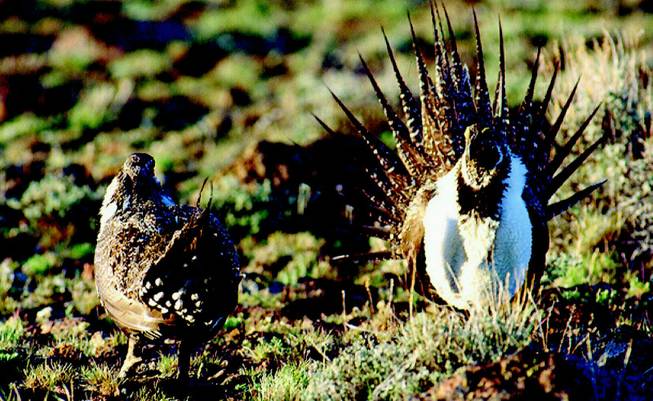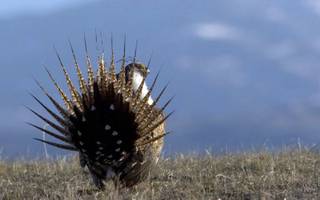
Nevada Division of Wildlife / AP
A female sage grouse, left, views a strutting male sage grouse during mating season, in this April, 2001 file photo taken in northwestern Nevada.
Sunday, July 21, 2013 | 2 a.m.
As firefighters waged a battle against a massive wildfire south of Reno this month, experts paid close attention to a secondary but vital issue — the condition of mountain terrain crucial to a chicken-sized bird poised for potential listing as an endangered species.
The Pine Nut Mountains, where the 37.5-square-mile Bison fire erupted July 4, provide crucial habitat for a unique subspecies of sage grouse that exists only along a swath of land straddling the Nevada-California border.
As soon as next month, the U.S. Fish and Wildlife Service is to decide whether the “bistate” population of sage grouse — which now numbers about 7,000 — should be listed as threatened or endangered, a status that comes with what could be widespread implications for land use across the region.
If significant portions of that habitat burned, the possibility that the tipping point for listing might be reached was very real.
Loss of sagebrush habitat to wildfire and the subsequent invasion of the land by cheatgrass or other invading vegetation is one of the most dire threats the bird faces.
It appears, experts say, that the most important habitat for grouse in the Pine Nuts — land crucial for both mating and as summer stomping grounds — was spared. And in an irony of sorts, the damaging fire may have helped ease one of the other biggest threats faced by the bistate sage grouse, the continuing intrusion of pinyon-juniper forests into the sagebrush-dominated landscape needed by the bird.
For years, land managers have recognized the need to thin pinyon-juniper stands in the Pine Nuts and treat the landscape with prescribed fire. But a combination of politics, policies and limited funding has prevented that from occurring, said Carl Lackey, a Nevada Department of Wildlife biologist who surveyed the fire area from the air to gauge effects on grouse habitat.
“It needed to be done, but it was never able to be done,” Lackey said. “Only recently has it started to happen, and only on a small scale.”
To a significant degree, the lightning-sparked Bison fire did the job.
“You hate to see that much land burned, but it did what we’ve been wanting to do for a long time,” Lackey said. “Mother Nature trumped politics. That fire just burned through all that (pinyon-juniper).”
Ted Koch, Nevada director for the U.S. Fish and Wildlife Service, also watched the fire closely. Koch was particularly concerned it would push north and destroy the last active “lek,” an area where male grouse gather and strut their stuff prior to mating, in the northern Pine Nuts.
“In the blink of an eye, things could change dramatically for the bistate,” Koch said as winds were fanning the Bison fire.
Later, Koch agreed it appeared the most important grouse habitat, including the threatened lek near the fire’s northern boundary, had survived the fire and that the burning of so much pinyon-juniper could end up working in the bird’s favor.
Whether the latter ends up actually being the case, Koch and Lackey said, depends on what happens next.
Even as the fire neared full containment, officials with the U.S. Bureau of Land Management, U.S. Bureau of Indian Affairs, Nevada Division of Forestry and other entities were preparing plans to rehabilitate the fire area.
Experts say vast tracts of the burn zone that had been covered with encroaching pinyon-juniper would ideally be replaced with what existed 150 years ago — a landscape consisting of a mosaic of perennial bunch grasses, forbs and sagebrush, a more natural condition that would not only benefit sage grouse but other wildlife such as deer and bears.
“That’s what we had before we allowed those trees to march down the mountain,” said Matt Spaulding, range resource specialist with the Bureau of Indian Affairs. “We’ve got to restore something similar to that.”
What can’t be allowed to happen, Spaulding and others agree, is to allow cheatgrass to overtake the burn area. That non-native invader can become quickly established across fire-charred terrain and easily fuel future fires.
Land managers have had mixed success in restoring burn areas along the Pine Nut Mountains.
After the Ray May Fire farther south in the Pine Nuts burned thousands of acres in 2011, an effort to re-establish perennial grasses in the area failed to a large degree, Spaulding said. Cheatgrass is now gaining a foothold there.
If efforts to do better in the Bison fire area are to succeed, extra steps will likely be necessary, Spaulding said. Among them could be manual preparation of the soil to better ensure grass seed takes and grass successfully grows, a move that would likely come with added expense.
“If we just throw it on the ground by helicopter, we almost always lose it,” Spaulding said.
In August, the U.S. Fish and Wildlife Service is expected to determine whether the bistate sage grouse should be listed as an endangered or threatened species. The decision comes two years before one affecting the much larger greater sage grouse population across 11 Western states.
The decision will come before the outcome of rehabilitation efforts at the Bison fire area is known. But how the grouse population is affected in the long run is the most important question, Koch said.
“This could be an opportunity to enhance that habitat,” Koch said. “We do have an opportunity here, but honestly, I don’t know that we’re well-positioned to take advantage of it.”


Join the Discussion:
Check this out for a full explanation of our conversion to the LiveFyre commenting system and instructions on how to sign up for an account.
Full comments policy